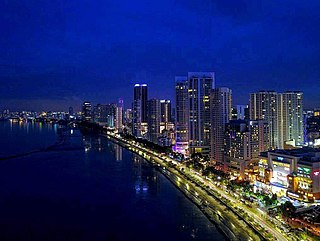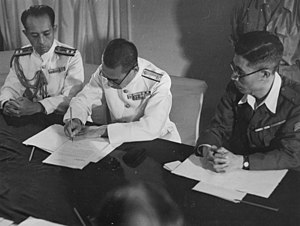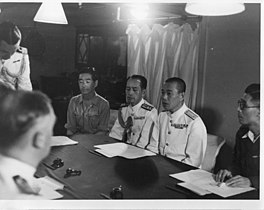
The Royal Malaysian Navy is the naval arm of the Malaysian Armed Forces. RMN is the main agency responsible for the country's maritime surveillance and defense operations. RMN's area of operation consists of 603,210 square kilometers covering the country's coastal areas and Exclusive Economic Zones (EEZ). RMN also bears the responsibility of controlling the country's main Sea Lines of Communications (SLOC) such as the Straits of Malacca and the Straits of Singapore and also monitors national interests in areas with overlapping claims such as in Spratly.

Vice Admiral Ernest John Spooner, DSO was one of the senior Royal Navy officers at Singapore during the World War II Japanese invasion of Malaya and the subsequent fall of Singapore.
During World War II, Operation Zipper was a British plan to capture either Port Swettenham or Port Dickson, Malaya, as staging areas for the recapture of Singapore in Operation Mailfist. However, due to the end of the war in the Pacific, it was never fully executed. Some of the proposed landings on Penang went ahead as planned to probe Japanese intentions, encountering no resistance. The planned deception for this attack was called Operation Slippery, whilst a small Special Operations Executive team led by Tun Ibrahim Ismail which landed in October 1944 managed to convince the Japanese that the landings were to be on the Isthmus of Kra, 650 miles (1,050 km) to the north.

The Malayan campaign, referred to by Japanese sources as the Malay Operation, was a military campaign fought by Allied and Axis forces in Malaya, from 8 December 1941 – 15 February 1942 during the Second World War. It was dominated by land battles between British Commonwealth army units and the Imperial Japanese Army, with minor skirmishes at the beginning of the campaign between British Commonwealth and Royal Thai Police. The Japanese had air and naval supremacy from the opening days of the campaign. For the British, Indian, Australian, and Malayan forces defending the colony, the campaign was a total disaster.

Force 136 was a far eastern branch of the British World War II intelligence organisation, the Special Operations Executive (SOE). Originally set up in 1941 as the India Mission with the cover name of GSI(k), it absorbed what was left of SOE's Oriental Mission in April 1942. The man in overall charge for the duration of its existence was Colin Mackenzie.

His Majesty's Naval Base, Singapore, also Her Majesty's Naval Base, Singapore, alternatively known as the Singapore Naval Base, Sembawang Naval Base and HMS Sembawang, was situated in Sembawang at the northern tip of Singapore and was both a Royal Navy shore establishment and a cornerstone of British defence policy in the Far East between the World Wars. From 1921 to 1941 it was a base of the China Station and from 1941 to 1958 it was a base for the Far East Fleet. Today, it is a commercial dockyard but British military activity still exists at the British Defence Singapore Support Unit (BDSSU).

The then British colony of Malaya was gradually occupied by the Japanese between 8 December 1941 and the Allied surrender at Singapore on 16 February 1942. The Japanese remained in occupation until their surrender to the Allies in 1945. The first Japanese garrison in Malaya to lay down their arms was in Penang on 2 September 1945 aboard HMS Nelson.

HMS Rotherham was an R-class destroyer of the British Royal Navy during the Second World War, named after Captain Edward Rotheram, who commanded HMS Royal Sovereign during at the Battle of Trafalgar in 1805. Rotherham was completed in 1942 and equipped as a flotilla leader, having slightly reduced armament to allow for the increased complement and working space required. Decommissioned in 1945, the ship was sold to India in 1948, serving as INS Rajput (D141) until 1976, when she was scrapped.

The State of Penang, one of the most developed and urbanised Malaysian states, is located at the nation's northwest coast along the Malacca Strait. Unlike most Malaysian states, the history of modern Penang was shaped by British colonialism, beginning with the acquisition of Penang Island from the Sultanate of Kedah by the British East India Company in 1786. Developed into a free port, the city state was subsequently governed as part of the Straits Settlements, together with Singapore and Malacca; the state capital, George Town, briefly became the capital of this political entity between 1826 and 1832. By the end of the 19th century, George Town prospered and became one of the major entrepôts in Southeast Asia.

HMS Volage was a V-class destroyer of the British Royal Navy, commissioned on 26 May 1944, that served in the Arctic and the Indian Oceans during World War II. She was the fifth Royal Naval ship to bear the name.

The British Military Administration (BMA) was the interim administrator of British Malaya from August 1945, the end of World War II, to the establishment of the Malayan Union in April 1946. The BMA was under the direct command of the Supreme Allied Commander South East Asia, Lord Louis Mountbatten. The administration had the dual function of maintaining basic subsistence during the period of reoccupation, and also of imposing the state structure upon which post-war imperial power would rest.

Operation Tiderace was the codename of the British plan to retake Singapore following the Japanese surrender in 1945. The liberation force was led by Lord Louis Mountbatten, Supreme Allied Commander of South East Asia Command. Tiderace was initiated in coordination with Operation Zipper, which involved the liberation of Malaya.

Major General Sir John Jeremy Moore, was a British senior Royal Marine officer who served as the commander of the British land forces during the Falklands War in 1982. Moore received the surrender of the Argentine forces on the islands.
No. 44 Commando was a battalion size formation in the British Commandos, formed during the Second World War. The Commando was assigned to the 3rd Special Service Brigade and served in the Burma Campaign.
HMIS Kistna (U46) was a Black Swan-class sloop which served in the Royal Indian Navy (RIN) during World War II.

The Eastern Fleet, later called the East Indies Fleet, was a fleet of the Royal Navy which existed between 1941 and 1952.
Operation Mailfist was a planned Allied offensive to liberate Singapore from Japanese occupation during World War II. It was intended to follow on from the landing in Malaya, Operation Zipper, and take place between December 1945 and March 1946. However, it was not conducted as Japan surrendered shortly before Operation Zipper was to have been launched. Instead, Singapore was re-occupied in the unopposed Operation Tiderace.
This article lists important figures and events in the public affairs of British Malaya during the year 1945, together with births and deaths of prominent Malayans. Malaya remained under Japanese occupation until September, when British Military Administration was installed.

Rear Admiral Arthur David Torlesse, was a Royal Navy officer. He commanded the escort carrier HMS Hunter during the latter part of the Second World War, and the aircraft carrier HMS Triumph during the early months of the Korean War. In 1952, he commanded the task force that supported Operation Hurricane, the first British nuclear weapons test.

George Town, the capital city of the State of Penang, is the second largest city in Malaysia and the economic centre of the country's northern region. The history of George Town began with its establishment by Captain Francis Light of the British East India Company in 1786. Founded as a free port, George Town became the first British settlement in Southeast Asia and prospered in the 19th century as one of the vital British entrepôts within the region. It briefly became the capital of the Straits Settlements, a British crown colony which also consisted of Singapore and Malacca.





















